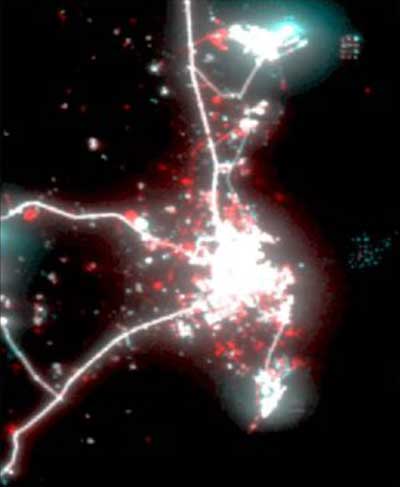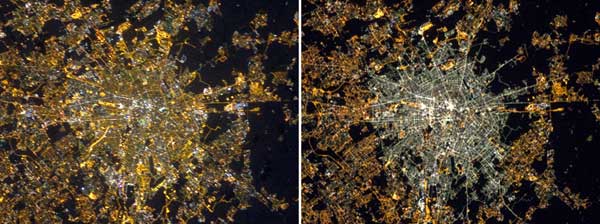The transition from sodium lights to LEDs, the so-called “lighting revolution”, was supposed to reduce energy consumption and bring back starry skies, but new satellite data indicate it’s not working out that way.
When scientists are disappointed with their results, it's usually because they were following a different hypothesis than where their data leads. In the case of the switch from sodium vapor lights to LEDs, though, it's more than that.
“Honestly, I had thought, assumed, and hoped that with LEDs we were turning the corner,” says Christopher Kyba (German Research Center for Geosciences). Kyba researches the spread of artificial lights and how it affects our nights, and as a former member of the board of directors of the International Dark Sky Association, he also advocates the use of improved lighting practices.
But in the November 22nd Science Advances, Kyba and colleagues show that we are farther from the goal of dark, starry skies than ever.

Kyba et al. / Science Advances
More Lights, Brighter Nights

Kyba et al. / Science Advances
The team used the Visible Infrared Imaging Radiometer Suite (VIIRS) instrument on the Suomi National Polar-orbiting Partnership weather satellite to measure the change in global light emissions between October 2012 and October 2016. The VIIRS instrument is the first-ever calibrated satellite radiometer designed to measure nighttime lights – earlier investigations were often based on uncalibrated sensors on military satellites.
VIIRS observes the Day/Night band (DNB), which picks up visible through near-infrared wavelengths. Each pixel covers ½ square kilometer, a higher spatial resolution than previous instruments, which enables scientists to investigate neighborhood-scale changes, rather than city or national, for the first time.
The researchers’ findings will not please astronomers: Earth’s nights are becoming brighter.
Between 2012 and 2016, these satellite data show that our planet brightened by 9.1%, an annual increase of roughly 2.2%. Artificially lit outdoor area also grew by 2.2% per year. Only very few places show a decrease in lighting (mostly war-torn countries like Syria and Yemen), while some of the already brightest-lit countries remained stable, among them Spain, Italy and the United States. With few exceptions, all countries in Asia, Africa, and South America emit significantly more light now than they used to five years ago.
That in itself isn’t unexpected — artificial lighting has long been an indicator for growing wealth and population. What’s surprising is that the ongoing transition to LEDs isn’t having a contrary effect.
“While we know that LEDs save energy in specific projects, for example when a city transitions all of its street lighting from sodium lamps to LED,” Kyba explains, “when we look at our data at the national and the global level, it indicates that these savings are being offset by either new or brighter lights in other places.”

International Dark-Sky Association / NASA
It's a rebound effect: Cheaper lights lead not to savings in energy consumption, but to more light. And that’s not just bad news for astronomers.
“Since the first emergence of life, the biological world was organized to a large extent by natural cycles of variation in light,” explains Franz Hölker (Leibniz Institute of Freshwater Ecology and Inland Fisheries, Germany). “From an evolutionary perspective, artificial light at night is a very new stressor.”
Because electricity brings light to places, times, and intensities at which it doesn’t naturally occur, many organisms have no chance to adapt. Their natural light cycles are fundamentally disrupted. About 30% of vertebrates and more than 60% of invertebrates on our planet are nocturnal, but outdoor artificial light also affects plants and microorganisms, and scientist are only beginning to learn about its possible negative effects on human health.
Blue vs. Amber LEDs
To make matters worse, the DNB is insensitive to wavelengths below 500 nanometers — blue light, which the atmosphere scatters more than other visible wavelengths. Unfortunately, many popular LED lights peak at these wavelengths.
It doesn’t have to be this way. “One of the really huge advantages of LEDs is that it’s possible to make very many different colors,” Kyba insists. “Cities can buy lamps that are not white, that have this blue component completely removed.” However these “PC Amber” or “True Amber” lights are so far used almost exclusively in designated dark-sky places.
Nevertheless, Kyba and his colleagues remain open to working with cities, local governments, and industry partners to reverse this trend: “The real dream is that we have great vision on the streets, never really experience an uncomfortably dark place inside of a city, but because the light is used much more efficiently, would have more stars to see in the sky.”
Find more information and resources for local change in Sky & Telescope's Saving Dark Skies section.
 0
0









Comments
You must be logged in to post a comment.